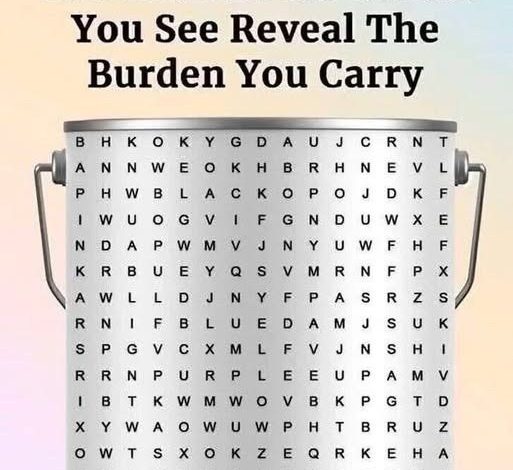More Than Preference, How Colors Reflect Your Mood and Mind!

ADVERTISEMENT
🎨 When Color Speaks First
Long before we utter a word, color begins the conversation. The hues we wear, the tones we surround ourselves with, the shades we instinctively reach for — they whisper the truths we haven’t yet named. Color isn’t mere decoration. It’s emotional language. A mirror to our inner world, often revealing what even we haven’t fully grasped.
ADVERTISEMENT
Most people think of color in simple terms: “I like blue,” “I don’t like yellow.” But our preferences are rarely random. They’re emotional signatures — subtle indicators of what we long for, what unsettles us, what we’re trying to avoid. Every color we choose carries meaning. And every color we reject speaks just as loudly.
ADVERTISEMENT
❤️ Red: The Pulse of Life
Red is raw energy. It’s the color of blood, passion, drive, and visibility. When you’re drawn to red, it often signals a craving for vitality — to feel alive, empowered, and seen. Red moves. It demands. It awakens.
But red also warns. It can reflect inner tension, anger, or a restless need for release. People often wear red during low moments without realizing it — as if calling energy back into their bodies. It’s the color that shouts when silence feels unbearable.
Avoiding red, on the other hand, may suggest a discomfort with confrontation — not just with others, but with oneself. Red exposes. It asks for boldness. Steering clear of it can be a way to stay hidden, emotionally guarded.
💙 Blue: Serenity and Solitude
Blue is the breath after chaos. It’s the color of still water, open skies, and quiet minds. When you’re drawn to blue, you may be seeking peace, clarity, or emotional balance. It’s the shade that soothes and steadies.
That’s why hospitals, offices, and meditation spaces often lean into blue — it calms the nervous system.
Yet blue can also signal emotional distance. Those who surround themselves with blue may crave connection but fear intensity. Blue comforts, but it can also isolate. It’s the color of safe harbors — and of oceans that separate.
💚 Green: Renewal and Grounding
Green is nature’s balm. It’s where the calm of blue meets the energy of yellow — a color of healing, growth, and emotional reset. When you’re drawn to green, you may be seeking stability after upheaval, or craving reconnection with your roots.
Muted greens are common in recovery spaces for a reason — they foster trust and signal safety. Psychologically, green tells the body: “You’re okay now.”
Avoiding green may suggest resistance to change or discomfort with vulnerability. Green invites openness. Rejecting it can reflect a fear of new beginnings or emotional exposure.
💛 Yellow: Lightness and Awakening
Yellow is the spark. It’s curiosity, intellect, and joy. When you’re drawn to yellow, you may be craving clarity, warmth, or a fresh start. It’s the color that lifts, energizes, and brightens.
But yellow is also the most visible hue — and with visibility comes vulnerability. Those who avoid yellow may fear being seen, judged, or misunderstood. In excess, yellow can even overwhelm — too much light can blind.
In heavy times, small touches of yellow can reintroduce hope. That’s why it often appears during transitions — after grief, heartbreak, or long emotional winters.
💜 Purple: Depth and Transformation
Purple is the meeting point of red’s energy and blue’s calm. It’s a color of contradiction — introspective, spiritual, and complex. Historically tied to royalty and mysticism, purple invites reflection and evolution.
When people gravitate toward purple, they’re often navigating change — emotional, creative, or spiritual. It signals a readiness to grow, even if the path ahead is uncertain.
Avoiding purple may reflect discomfort with ambiguity. Depth can be daunting, and purple doesn’t offer easy answers.
⚫⚪⚪ Black, White, and Gray: The Quiet Language
Not all emotions wear bright colors. The neutrals — black, white, and gray — speak in whispers, but they speak powerfully.
- Black is often misunderstood. It’s not just somber — it’s protective. People drawn to black may be seeking strength, boundaries, or emotional containment. In chaos, black offers control.
- White is cleansing. It signals simplicity, renewal, and space. It’s often chosen when we need emotional distance or a fresh canvas. Yet in many cultures, white also marks mourning — not an end, but a transition.
- Gray is the pause. It reflects neutrality, detachment, and emotional fatigue. It’s common when we’re overwhelmed and need rest. But prolonged attraction to gray may suggest stagnation or numbness.
🧠 The Science and Story Behind Color
Our responses to color aren’t just cultural — they’re biological. Red raises heart rate. Blue lowers blood pressure. Yellow stimulates mental activity. These reactions are hardwired, but layered with personal and cultural meaning.
Culture adds nuance. In the West, white may symbolize purity; in parts of Asia, it represents loss. Red can mean love, danger, or celebration depending on context. Color doesn’t carry universal truths — it carries shared stories.
But beneath all variation lies one constant: color bypasses logic. It touches emotion first, thought second. That’s why a single shade can shift your mood before you even know why.
☕ Everyday Color, Everyday Emotion
The green mug you reach for each morning. The black hoodie that feels like armor. The burnt-orange sweater that comforts you during change — these aren’t random choices. They’re reflections of your emotional landscape.
After heartbreak, people often lean into darker tones — grounding shades that mirror introspection. During fresh starts, lighter and warmer hues emerge. Our color preferences trace our inner weather.
Even the colors we reject matter. Avoiding red might signal discomfort with assertiveness. Rejecting white could reflect resistance to letting go. Color speaks when words fall short.
👁️ Listening to Color
Next time a color draws you in — or pushes you away — pause. Ask yourself: What am I feeling? What am I needing?
Color isn’t just aesthetic. It’s emotional expression in disguise. The walls you paint, the clothes you wear, the light you choose — they’re all quiet declarations of your inner world.
So listen. Because sometimes, before you even know what you’re feeling, color already does.




